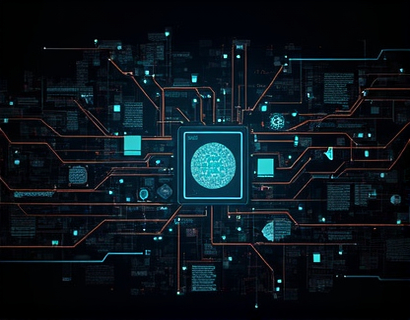Transforming User Experiences: The Synergy of Crypto and AI in Intelligent App Ecosystems
The intersection of cryptocurrency and artificial intelligence (AI) is giving rise to a new era of digital innovation, fundamentally altering the landscape of app ecosystems and user engagement. This transformative synergy is not just about enhancing existing technologies but creating entirely new paradigms for interaction, security, and value exchange. As we delve into this topic, it's essential to understand how these technologies, when combined, are reshaping the way we experience the digital world.
The Evolution of App Ecosystems
App ecosystems have evolved significantly over the past decade, from simple platforms connecting users to services to complex networks that integrate various functionalities and services. The introduction of blockchain technology has added a new dimension to these ecosystems, enabling decentralized, secure, and transparent interactions. Cryptocurrency, as a foundational element of blockchain, provides a medium for value exchange that is not reliant on traditional financial institutions, thus democratizing access and fostering innovation.
AI, on the other hand, has revolutionized the way apps process and analyze data, enabling more personalized and intelligent user experiences. The integration of AI into app ecosystems allows for dynamic content generation, predictive analytics, and automated decision-making, all of which enhance user engagement and satisfaction. When combined with blockchain, AI can operate in a trustless environment, further enhancing the reliability and efficiency of these ecosystems.
Enhanced Security Through Cryptography and AI
Security is a paramount concern in the digital age, and the combination of cryptocurrency and AI offers robust solutions. Blockchain's inherent security features, such as immutability and transparency, are complemented by AI's ability to detect and mitigate threats in real-time. AI algorithms can analyze patterns and anomalies in vast datasets, identifying potential security breaches before they occur. This proactive approach to security ensures that user data and transactions remain protected, building trust within the app ecosystem.
Moreover, AI-driven identity verification and authentication processes can reduce the risk of fraud and unauthorized access. By leveraging biometric data and behavioral analytics, AI can provide multi-factor authentication that is both secure and user-friendly. This synergy between cryptography and AI not only safeguards user information but also streamlines the user experience, making it more seamless and secure.
Personalized User Experiences Through AI
One of the most significant impacts of AI in app ecosystems is the ability to deliver highly personalized experiences. AI algorithms can analyze user behavior, preferences, and interactions to create tailored content and recommendations. This level of personalization goes beyond simple targeted advertising, offering users relevant and valuable services that enhance their overall experience.
For instance, in a decentralized application (dApp) powered by blockchain, AI can curate a personalized feed of news articles, financial insights, or entertainment content based on the user's historical interactions and preferences. This not only increases user engagement but also fosters a deeper connection between the user and the app ecosystem. The combination of blockchain and AI ensures that this personalized data is managed securely and transparently, further enhancing user trust.
Decentralized Finance (DeFi) and AI-Driven Financial Services
The convergence of cryptocurrency and AI is particularly evident in the realm of decentralized finance (DeFi). DeFi platforms leverage blockchain to provide financial services such as lending, borrowing, and trading without intermediaries. AI plays a crucial role in optimizing these services by analyzing market trends, predicting price movements, and automating trading strategies.
AI-driven algorithms can identify opportunities and mitigate risks in real-time, offering users more efficient and profitable financial solutions. For example, AI can manage decentralized portfolios, adjusting asset allocations based on market conditions to maximize returns while minimizing exposure to volatility. This level of automation and intelligence not only enhances the user experience but also makes financial services more accessible to a broader audience.
Supply Chain Transparency and Efficiency
Beyond financial services, the synergy of cryptocurrency and AI is transforming supply chain management. Blockchain provides a transparent and immutable ledger for tracking goods from production to delivery, ensuring authenticity and reducing fraud. AI can further optimize this process by analyzing data from various stages of the supply chain, predicting bottlenecks, and suggesting improvements.
For instance, AI can optimize inventory management by forecasting demand based on historical sales data and market trends. This not only reduces waste but also ensures that products are available when and where they are needed. The combination of blockchain and AI in supply chain management enhances transparency, efficiency, and trust, benefiting both businesses and consumers.
Smart Contracts and Automated Processes
Smart contracts, self-executing contracts with the terms directly written into code, are a cornerstone of blockchain technology. When combined with AI, smart contracts can become even more powerful, automating complex processes with precision and reliability. AI can analyze conditions and execute actions based on predefined criteria, reducing the need for human intervention and minimizing errors.
In the context of app ecosystems, smart contracts can facilitate seamless interactions between different services and platforms. For example, a user can trigger a series of automated actions, such as transferring cryptocurrency, accessing premium content, or receiving a reward, all through a single smart contract. This level of automation not only streamlines processes but also enhances the overall user experience by making it more intuitive and efficient.
User-Centric Design and AI-Enhanced Interfaces
The integration of AI into app ecosystems also extends to the design and user interface (UI) of applications. AI can analyze user interactions and feedback to continuously improve the UI, making it more intuitive and user-friendly. Machine learning algorithms can identify common user pain points and suggest design changes to enhance usability.
Moreover, AI-powered chatbots and virtual assistants can provide real-time support and guidance, helping users navigate complex app functionalities. These AI-driven interfaces not only improve the user experience but also reduce the workload on human support teams, leading to cost savings and higher efficiency.
Challenges and Considerations
While the potential of combining cryptocurrency and AI in app ecosystems is vast, there are several challenges and considerations to address. One of the primary concerns is regulatory compliance. The decentralized nature of blockchain and the use of cryptocurrency raise questions about jurisdiction, taxation, and legal frameworks. App developers must navigate these regulatory landscapes carefully to ensure compliance and avoid legal issues.
Another challenge is the technical complexity involved in integrating blockchain and AI. Developing robust and scalable solutions requires expertise in both domains, which can be a barrier for smaller developers. However, as the technology matures and more tools become available, these challenges are likely to diminish.
Privacy is also a critical concern. While AI can enhance security, it also raises questions about data privacy and user consent. It is essential to implement transparent and ethical data practices, ensuring that users have control over their information and understand how it is being used.
Future Prospects and Innovations
Looking ahead, the synergy between cryptocurrency and AI is poised to drive even more innovative solutions in the app ecosystem. One area of potential growth is the development of AI-powered NFT (Non-Fungible Token) marketplaces, where unique digital assets can be created, traded, and verified with enhanced security and transparency.
Another exciting frontier is the integration of AI with the Internet of Things (IoT) within blockchain-based app ecosystems. This combination can enable smarter, more autonomous devices that interact seamlessly with each other and with users, creating a truly interconnected digital world.
Furthermore, the rise of Web3, a decentralized internet powered by blockchain, AI, and other emerging technologies, promises to redefine the internet as we know it. Web3 applications will offer users greater control over their data, more secure interactions, and new forms of value creation and exchange.
In conclusion, the intersection of cryptocurrency and AI is not just a technological advancement but a transformative force reshaping app ecosystems and user experiences. By enhancing security, personalization, and efficiency, these technologies are paving the way for a more intuitive, secure, and engaging digital future. As the tech landscape continues to evolve, the potential for innovation and growth remains immense, offering exciting opportunities for developers, businesses, and users alike.










































